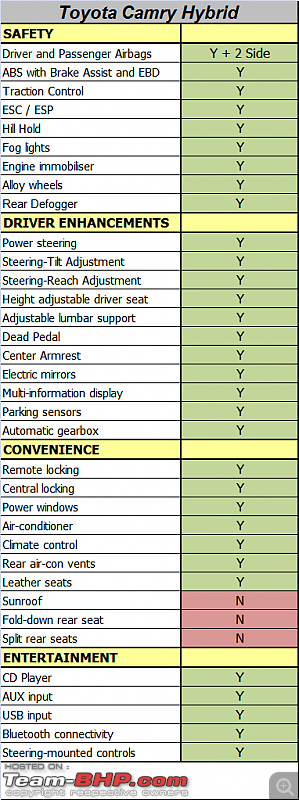| |||||||
| Search Forums |
| Advanced Search |
| Go to Page... |
 |
| Search this Thread |  223,477 views |
| | #1 |
| Team-BHP Support  | Review: 7th-gen Toyota Camry Hybrid (2013) The Toyota Camry Hybrid has been launched in India at a price of Rs. 29.75 lakhs (ex-Delhi). What you'll like: • Fuel-efficient, environment-friendly Hybrid technology. ARAI rating = 19.16 kpl • 5 star equipment (reclining rear seats, triple-zone climate, powered sunshade, ventilated seats etc.) • Spacious premium sedan with outstanding levels of refinement • Lexus-esque exterior styling. Great road presence • Neutral ride and handling balance. Much improved over earlier Camry generations • Toyota’s bullet-proof reliability and superb after-sales service What you won't: • Rs. 5 Lakh premium for the Hybrid tech & improved equipment levels (over the regular Camry) • Diesel competition (Skoda Superb, VW Passat) is priced noticeably lower • Unknown maintenance costs & battery life of the Hybrid system in Indian conditions • Numb driving feel. Not as dynamically accomplished as the Europeans either • Only D2 segment sedan without a sunroof 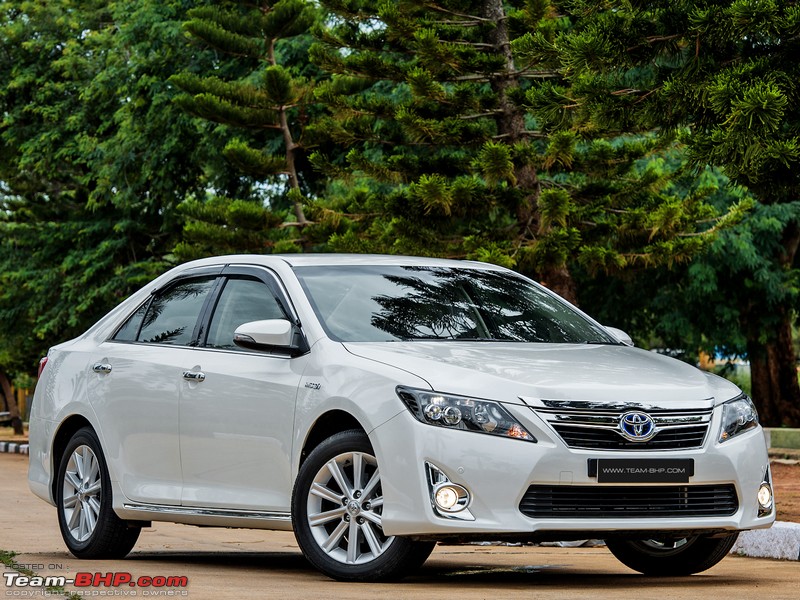 Last edited by GTO : 4th November 2015 at 17:47. Reason: Removing last point on airbag - Toyota now offers more airbags |
| |  (31)
Thanks (31)
Thanks
 |
| The following 31 BHPians Thank Vid6639 for this useful post: | .anshuman, blackwasp, CARDEEP, car_crazy1400, Contrapunto, dkaile, ecosport rules, Flyer, GTO, IronH4WK, karpusv, KarthikK, mroptimist, navin, noopster, NPV, R2D2, Rehaan, Researcher, roby_dk, RSR, S2!!!, SDP, SmartCat, Tejas@perioimpl, theexperthand, uday.ere, V.Narayan, vb-saan, virtualdanger, vredesbyrd |
| |
| | #2 |
| Team-BHP Support  | re: Review: 7th-gen Toyota Camry Hybrid (2013) Since the Toyota Camry has already been reviewed by Team-BHP, this report will only focus on the changes with regards to the Hybrid. For easy reference, here are direct links to the complete Toyota Camry road-test: Exterior Design & Build Quality Interior design, space, practicality & features Engine, Ride, Handling & Braking Other Pertinent Points The Smaller & Significant Things Last edited by Rehaan : 28th August 2013 at 18:03. |
| |  (13)
Thanks (13)
Thanks
 |
| The following 13 BHPians Thank Vid6639 for this useful post: | .anshuman, GTO, IronH4WK, KarthikK, navin, R2D2, Rehaan, Researcher, roby_dk, RSR, SS-Traveller, Tejas@perioimpl, vb-saan |
| | #3 |
| Team-BHP Support  | 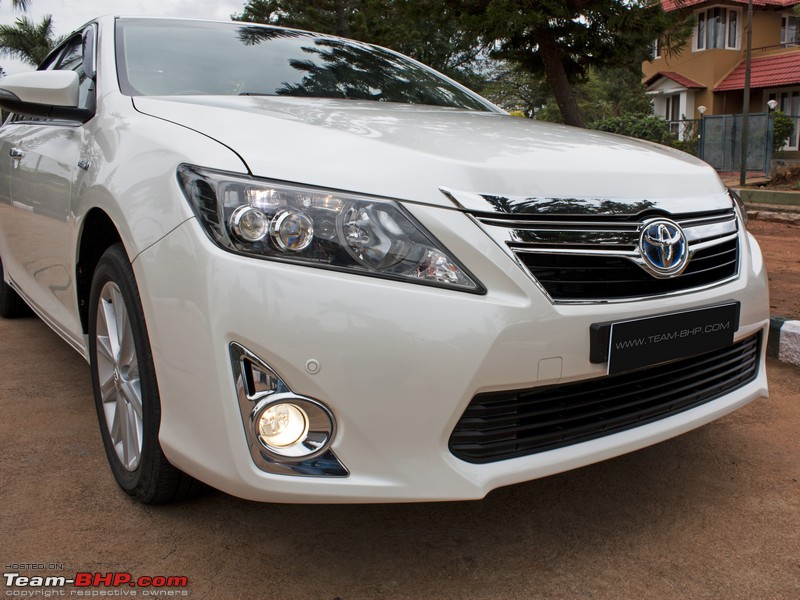 This time last year, Toyota brought in the 7th generation Camry to India. Toyota claims the new Camry laps up 20% market-share even with a petrol only option. That said, the Camry has been comprehensively outsold by the likes of the Skoda Superb & VW Passat. The slice of the pie would have been much larger, had there been a diesel option on offer. At 2.5L in size, the Camry's petrol motor is a large displacement and not the most efficient, with owners reporting 6 - 7 kpl in city traffic. Toyota doesn't have a diesel mill for the 7th gen Camry anywhere in the world. It wouldn't have been a viable proposition to engineer a diesel powertrain just for India, as the numbers wouldn't justify the effort. The Camry's no. 1 market is the United States which is largely dominated by petrol cars. On the other hand, the Camry is available with a Hybrid option internationally. Toyota has decided to locally assemble the Camry Hybrid in India. Of course, the easiest option would have been to bring it in via the CBU route, but that would have resulted in steep import taxes being imposed, and thus an exorbitant price tag. The Prius suffers a similar fate; being a CBU import has resulted in the Prius carrying a heftier price than the larger, more luxurious Camry. The Indian government has recently announced the National Electric Mobility Mission Plan (NEMMP) 2020 that sets the vision, lays targets and provides joint Government – Industry vision for realizing the huge potential for efficient + environment friendly electric vehicle technologies (including hybrids). With that, hybrid cars are guaranteed to receive direct subsidy, reducing the cost of ownership. Toyota wants to get a head start on the local assembly of hybrids. While every manufacturer has diesels, few have hybrid technology for mass market cars. This could be a huge competitive advantage. Make no mistake, the Camry Hybrid is Toyota's way of starting off. This is the 1st Hybrid automobile to be assembled in India and will inevitably make way for future Toyota Hybrids to be manufactured locally. To view Samurai's excellent report on Hybrid Technology, click here. There is definite potential for hybrids in the Indian mass market: 1. The price gap between diesel & petrol fuels has gotten slimmer. 2. Hybrids can be incredibly fuel-efficient in the stop-start driving conditions we witness in Indian cities. Fact is, the Camry Hybrid gets better fuel efficiency in the city (related link) than the highway (where it primarily uses the petrol engine). 3. If manufacturing is localised, the price difference with mainstream high-volume cars can come down. Of course, we don't have a clue about the cost of a replacement battery 10 years down the line (time guesstimated). India gets the Japanese spec Camry in the fully loaded trim. Externally, the Camry Hybrid is similar to the regular Camry, barring a few cosmetic changes. The front gets a redesigned bumper and grill. The headlights are now LED (low beam only) with a smoked effect. The Toyota logos (front and back) wear a blue hue denoting the Hybrid tech under the hood. The Hybrid also rides on larger 17” wheels vs the 16” of the Petrol. Front end actually looks sportier than the regular Camry, thanks to the smoked lights and aggressive bumper design:  LED lights for the low beam with dual projectors look stunning. High beam is regular halogen. Even the parking lamp is an LED. You don't get washers here, as LED headlamps don't need a washer spray by law: 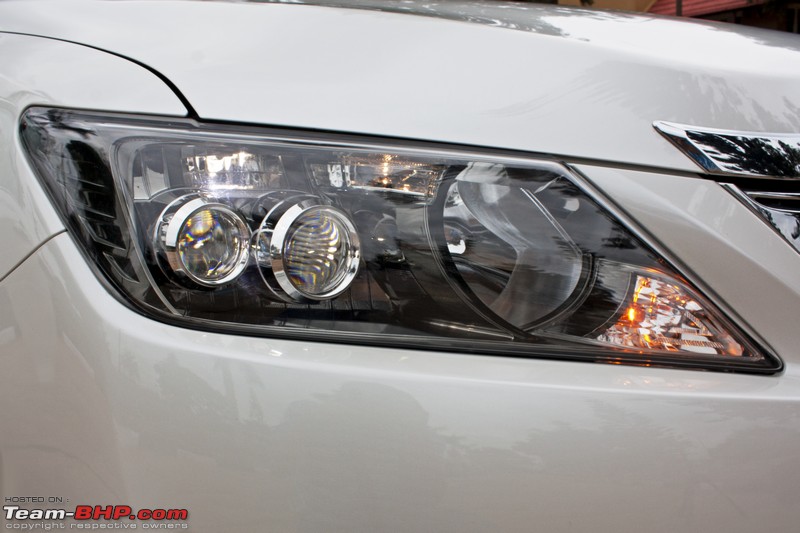 Foglamps are now located at the bumper corners: 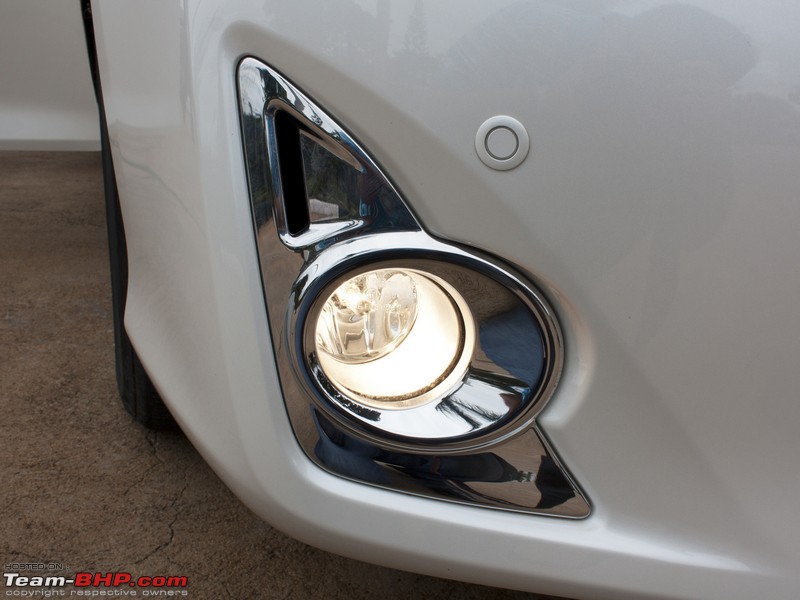 Lexus-like rear with LED tail lamps is unchanged from the regular car: 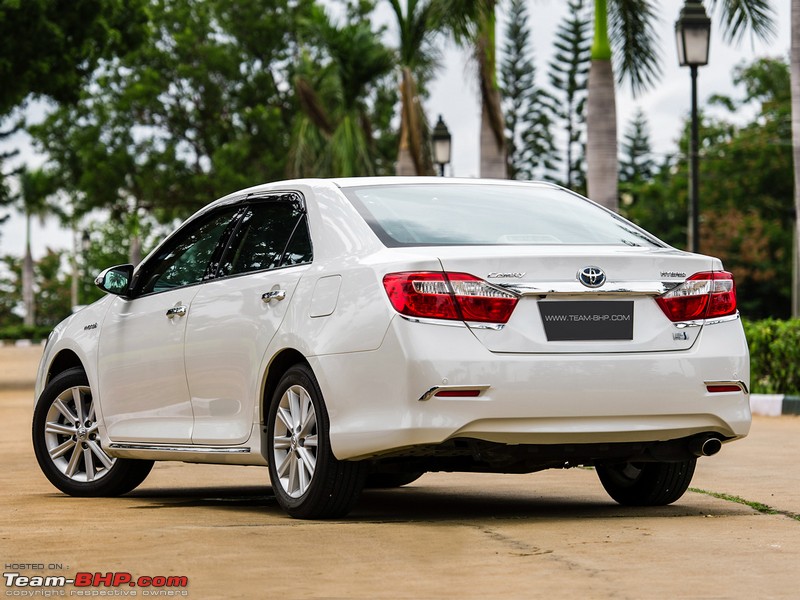 Blue hue around the T denotes Hybrid technology under the hood: 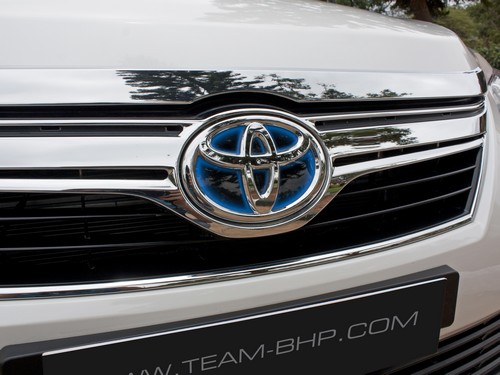 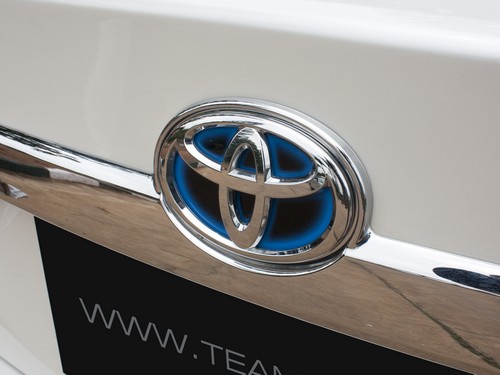 There's a HYBRID badge on the boot as well as a small Hybrid Synergy Drive logo: 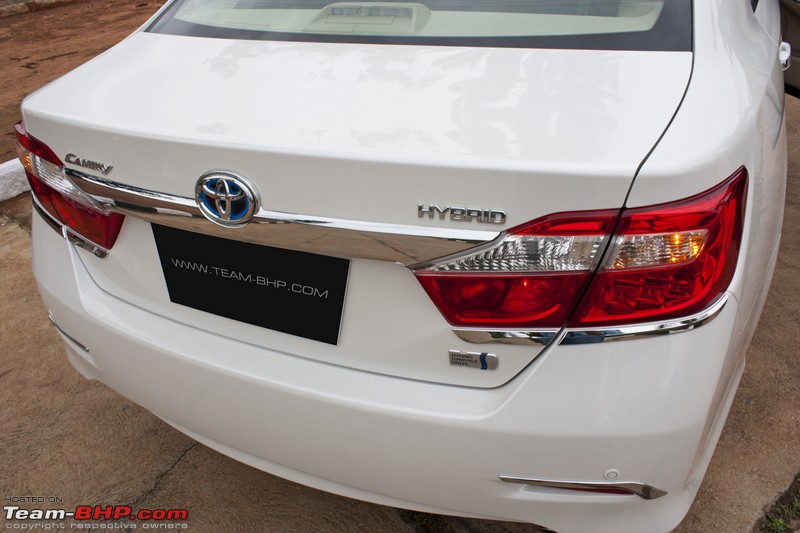 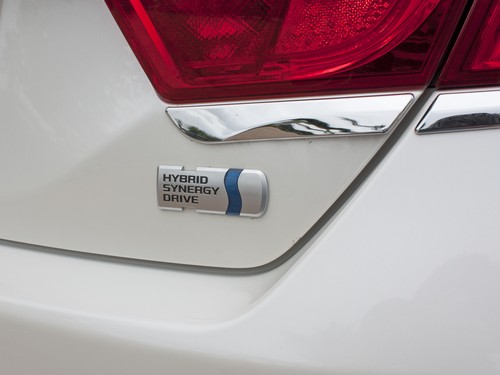 Both fenders wear the Hybrid logo: 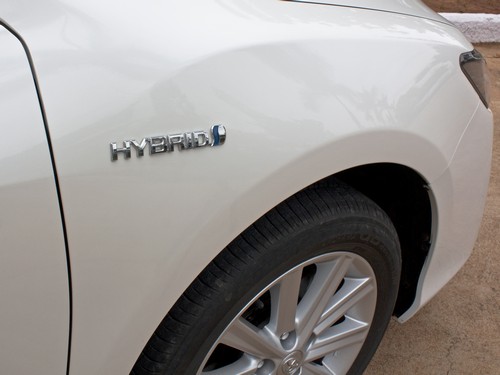 Camry Hybrid wears 215/55 Yokohama (low road noise) tyres on larger 17" wheels: 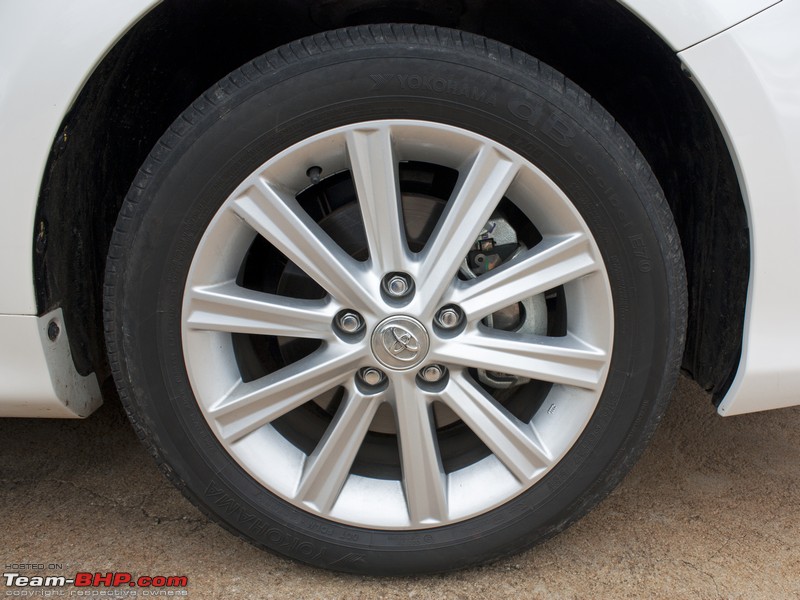 Last edited by Rehaan : 28th August 2013 at 18:13. |
| |  (24)
Thanks (24)
Thanks
 |
| The following 24 BHPians Thank Vid6639 for this useful post: | .anshuman, car_crazy1400, Contrapunto, dkaile, Flyer, GTO, iliketurtles, IronH4WK, KarthikK, rave20, Rehaan, Researcher, roby_dk, RSR, S2!!!, samabhi, SmartCat, Tejas@perioimpl, theexperthand, uday.ere, vb-saan, virtualdanger, vredesbyrd, Yuvuz |
| | #4 |
| Team-BHP Support  | re: Review: 7th-gen Toyota Camry Hybrid (2013) 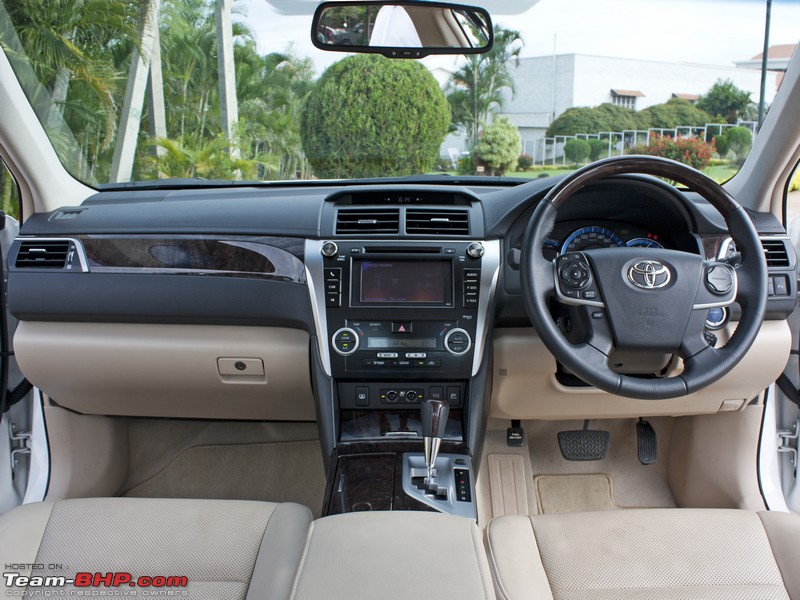 When we reviewed the Camry last year, one of the biggest grouses we had was with its lack of features, especially for back seat passengers (the target customer for Toyota). Toyota has addressed concerns in this department, and the Hybrid is loaded to the gills. The Hybrid is actually the top spec when it comes to features vs the regular Camry that was more of a mid spec variant. It appears that with the Hybrid, Toyota aren't just looking at competing with Skoda, VW and Honda, but also BMW, Mercedes and Audi. With the additional features, technology and sheer size, Toyota calls this Camry the "Local Lexus". The Hybrid gets a long list of goodies like 3 zone climate control, electrically reclining rear seats (by 8 degrees), powered rear blind, manual blinds for the (rear) side windows, foldable front passenger headrest, rear audio controls and a rear seat grab rail. And that’s just at the rear. At the front, the driver & passenger get 8-way adjustable electric seats, power tilt / telescopic steering adjustment and 2 memory presets for the driver's seat, mirrors and steering. The front seats also get ventilation. Additionally, the safety features have been given a once over. VSC (Vehicle Stability Control), Traction Control and Hill Hold Assist are now standard on the Hybrid. The driver and front passenger get side airbags (apart from the standard 2 in the front). The reversing camera is standard equipment on the Hybrid (optional on the regular Camry). The dials get a blue ring around them, while the tachometer is replaced by a meter showing the mode of operation. Ready light turns on when you start the car: 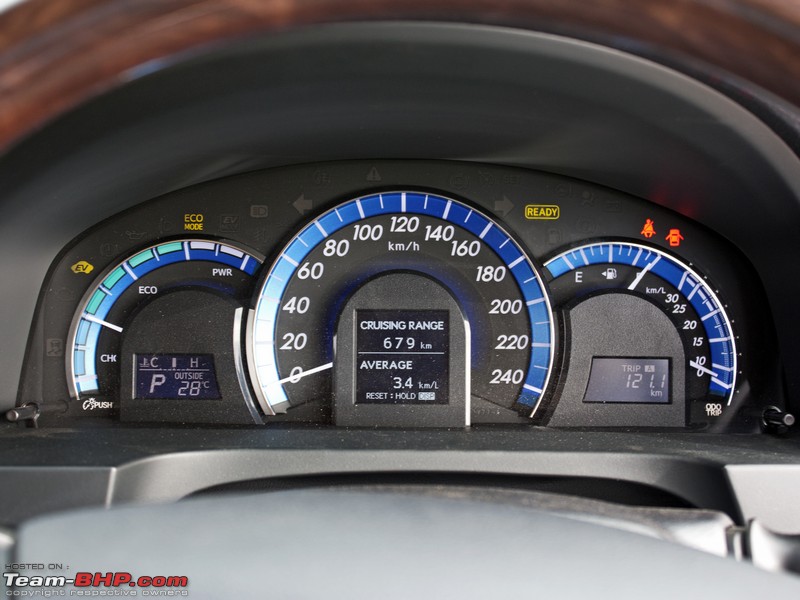 Blue POWER button switches on the electricals, but you don't hear a thing: 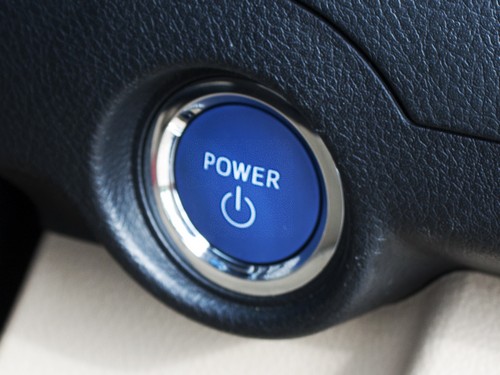 Hybrid works in 3 modes (via the 2 buttons on the right) : ECO, EV and ECO mode OFF. The 2 round knobs are for the ventilation function on the front seats. The button on the left is for the powered rear sun blind: 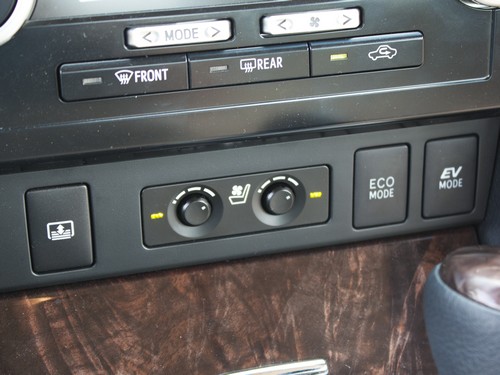 No "S" mode or manual tiptronic here. The "B" is for engine braking when going downhill: 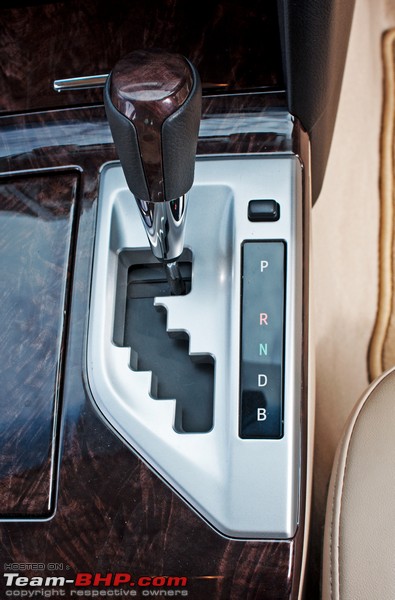 Steering wheel is electrically adjustable for rake & reach: 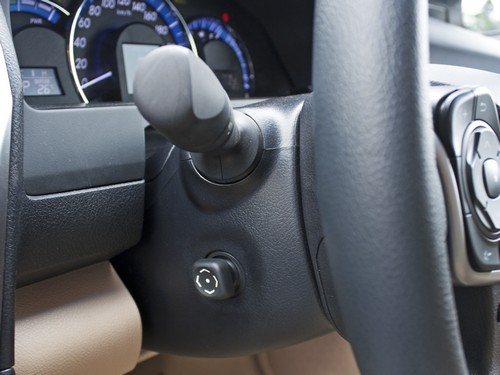 Memory settings for the driver's seat, outside mirrors and steering wheel:  Front occupants get side airbags:  Front passenger seat headrest flips down so that the bossman on the back seat has a better view: 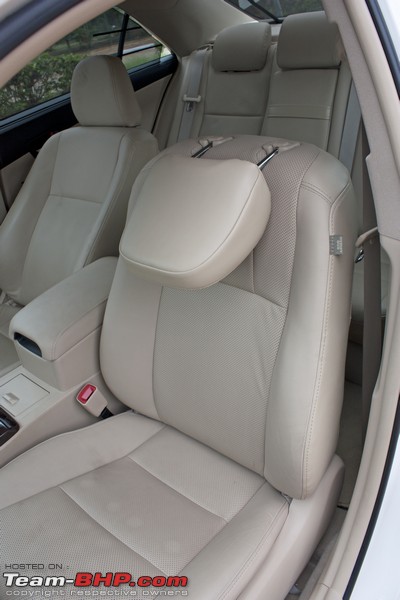 Luxurious rear seats offer superb comfort. Under thigh support & legroom are amongst the best in the segment. Rear seat backrest - for both sides - can recline by 8 degrees, via a button on the center armrest: 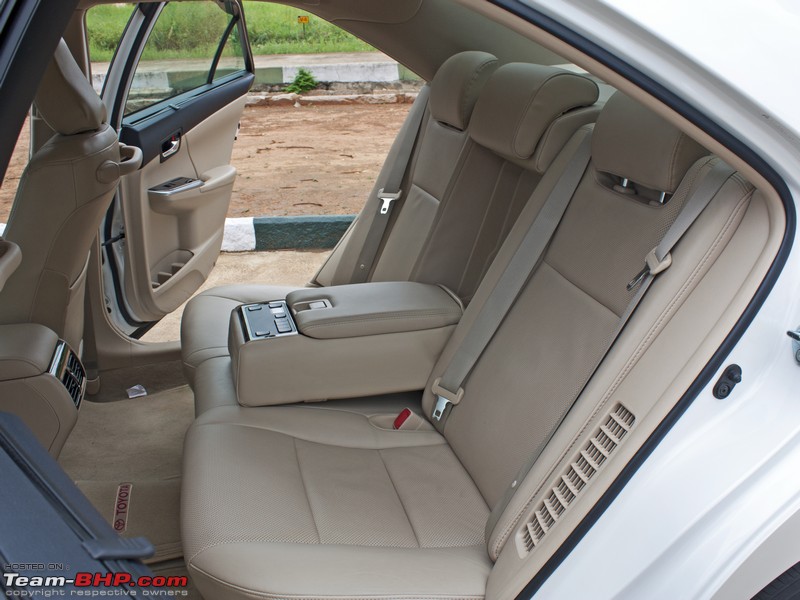 Even the headrests are redesigned for better comfort:  Rear armrest has controls for the climate control, audio system, rear sun blind and rear seat recline angle: 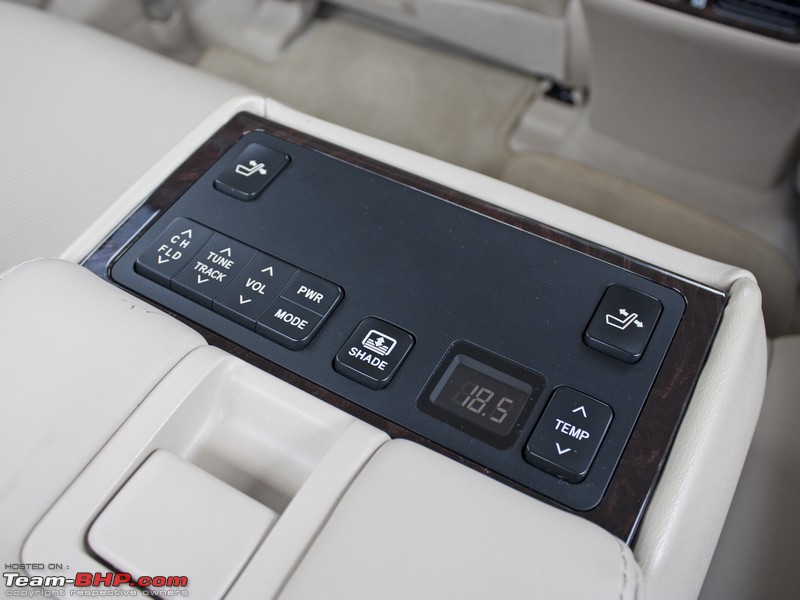 You get a neat felt-lined cubby in the armrest. 12V socket too:  Powered sun blind (rear windshield) can be operated from the rear armrest, or by the driver from the center console: 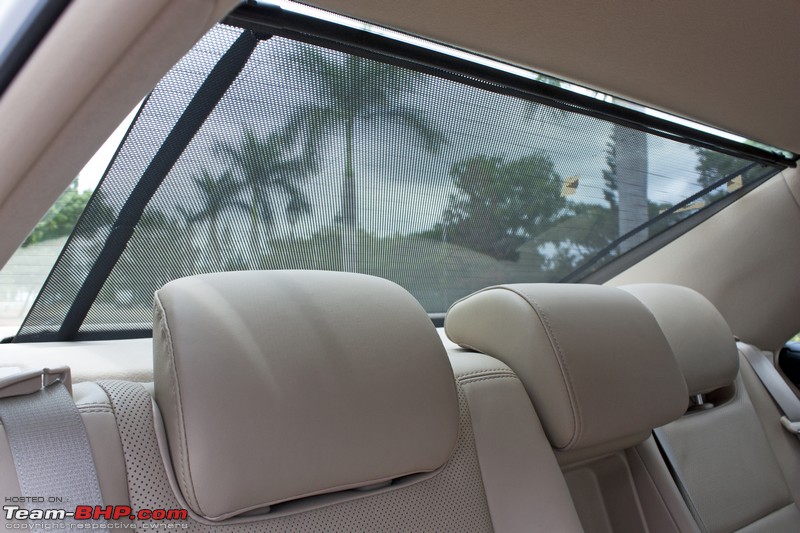 Rear windows get manual sun blinds. These are sorely missed on the regular Camry: 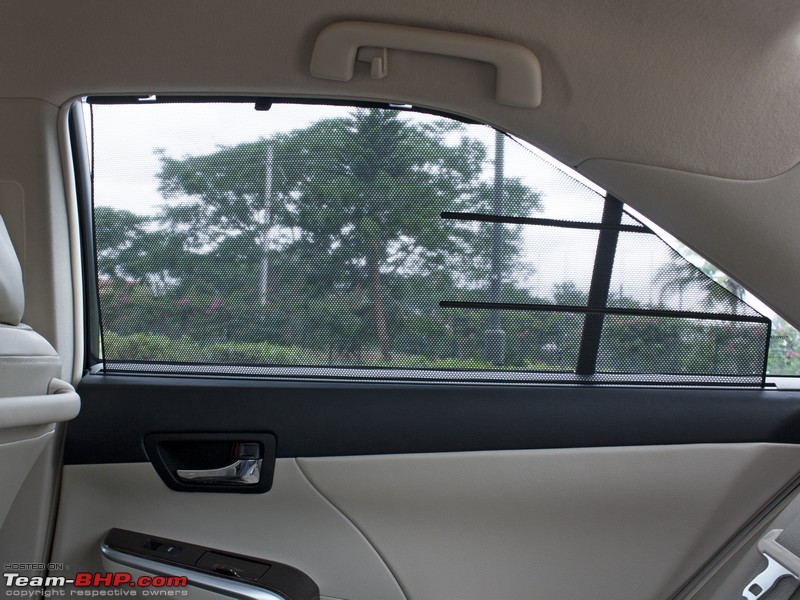 Like in the regular Camry, the front passenger seat can be adjusted from the back, via these buttons on the side:  Both front seats get huge assist grips for rear passengers. Useful when driving through the hills: 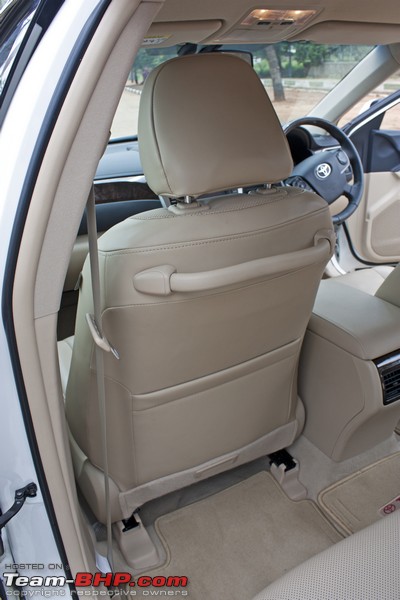 The otherwise cavernous boot space is somewhat compromised by the Hybrid's battery pack:  Last edited by Rehaan : 28th August 2013 at 18:21. |
| |  (27)
Thanks (27)
Thanks
 |
| The following 27 BHPians Thank Vid6639 for this useful post: | .anshuman, Avikbrio, blackwasp, carrazy, cityvic, dkaile, ecosport rules, GTO, IronH4WK, KarthikK, neil.jericho, noopster, rave20, Rehaan, Researcher, roby_dk, RSR, S2!!!, samabhi, SmartCat, speed kills, SS-Traveller, Tejas@perioimpl, uday.ere, vb-saan, virtualdanger, vredesbyrd |
| | #5 |
| Team-BHP Support  | re: Review: 7th-gen Toyota Camry Hybrid (2013)  The talking point is under the hood...or in this case, inside the boot as well. Toyota calls their Hybrid Powertrain, the Hybrid Synergy Drive (HSD). It’s a Series Parallel Hybrid System that allows power to be transmitted to the wheels via the electric motor, the petrol engine or both. The petrol engine can also power the motor to charge the batteries. This excellent thread tells you all you need to know about Toyota’s Hybrid Synergy Drive tech. For the Camry Hybrid, Toyota uses a 2.5L (2AR-FXE) petrol engine with a few differences. This engine has VVT-i only for the intake valves, and not Dual VVT-i like the regular Camry's 2.5L. It also runs on the Atkinson cycle as against the regular Otto cycle for internal combustion engines. The Atkinson cycle has superior efficiency (ARAI rating of 19.16 kpl) than the Otto cycle, although power and torque are lower. As a result, you get only 158 BHP from the Hybrid’s petrol engine (179 BHP from the regular Camry's petrol engine). Torque is also down to 213 Nm from 233 Nm. However, this power deficit is more than made up by the electric motor that can produce 141 BHP and 270 Nm torque. The total power available at the wheels isn't the sum of the two, but limited to a max of 202 BHP. The extra horsepower isn't immediately felt behind the wheel, thanks to the additional 150 kilos brought in by the Hybrid system. A majority of this weight is in the boot which houses the battery pack. The battery is an Ni-MH unit with a capacity of 6.5 Ah. It consists of 34 modules and 204 cells. The two motors drive the wheels through an Electronically Controlled CVT (E-CVT) gearbox. Sound damping even for the silent Hybrid. Heavy hood has 2 struts to help lifting it up:  Packed engine bay due to the internal combustion engine and 2 electric motors / generators:  That's the Hybrid power electronics module:  Battery pack with cooling fan in the boot:  Last edited by GTO : 28th August 2013 at 16:12. |
| |  (22)
Thanks (22)
Thanks
 |
| The following 22 BHPians Thank Vid6639 for this useful post: | .anshuman, Avikbrio, carrazy, condor, dkaile, Grace, GTO, IronH4WK, KarthikK, neil.jericho, noopster, R2D2, rave20, Rehaan, Researcher, roby_dk, RSR, S2!!!, Tejas@perioimpl, uday.ere, vb-saan, virtualdanger |
| | #6 |
| Team-BHP Support  | re: Review: 7th-gen Toyota Camry Hybrid (2013) 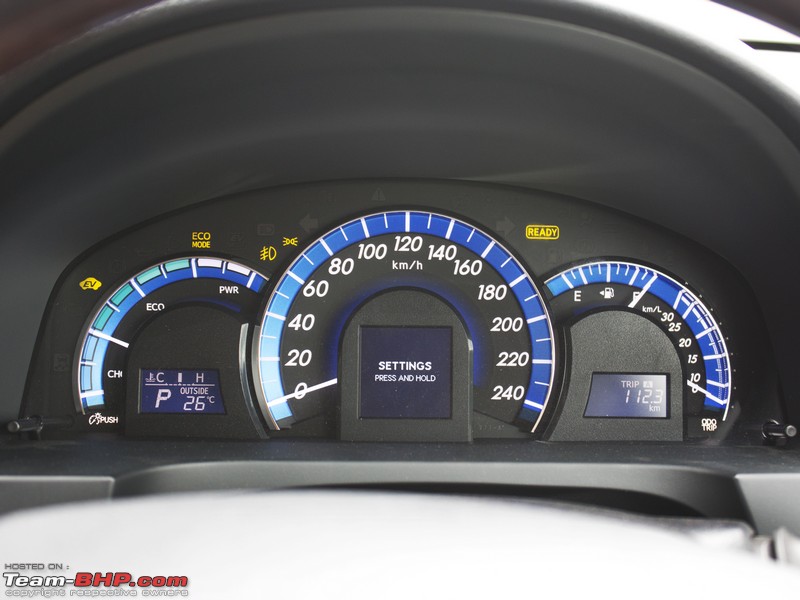 Step into the car and you’ll see a blue Power button (instead of a start/stop button). Pressing that button doesn't result in the usual sound of a starter motor cranking the engine to life; this does take a little getting used to. Instead, the dials and the “READY” indicator light up. That’s it. No tachometer here, but there is a gauge that tells you if the batteries are charging or if you're in ECO / Power mode. All you need to do after that is slot the gear lever into D and you're all set. If you dab the accelerator slightly, the car will start rolling with absolutely zero sound in electric mode. The petrol engine turns on only when extra shove is required, or if the batteries are below a certain charge level. There are 3 driving modes present for the driver to choose from. ECO, EV (Electric Vehicle) and ECO mode OFF. These driving modes have different characteristics which help to extract the max performance or efficiency. In all 3 modes, the car decides the way in which power is transmitted to the wheels. The gearbox doesn’t even have a tiptronic option. The average driver will never know what source is driving the wheels unless they look at the energy monitor on the display screen. It's completely seamless! The Hybrid drives like any other automatic car. If you’re observant, you'll eventually change your driving style to suit the Hybrid and extract even better efficiency. There's a large number of people out there who would take pleasure in seeing the fuel efficiency needle climb up (instead of the RPM needle).
The braking unit on the Camry Hybrid is a complex one. It uses two methods to slow the car down. One is the regular braking system with discs all round (friction brakes) and the other is the regenerative braking system. In essence, regenerative braking slows down the car by engaging a motor. The motor when engaged to the wheels turns, and the resultant resistance in turning the motor slows the car down. The motor actually starts working like a generator and produces electricity which is used to charge the battery pack. Basically, if you supply electricity to a motor, you get mechanical power and if you supply mechanical power, you get electricity and it becomes a generator. Again, both of these systems work in the background and you never know which one is slowing the car down. The regenerative braking system is activated when you are decelerating slowly. That is, during coasting or when you press the brake pedal lightly. Since the petrol engine shuts down when you're not pressing the accelerator pedal, there is no engine braking. Regenerative braking takes care of this aspect. When you press the brake pedal lightly, regenerative braking is used to slow the car down until a certain point. To come to an absolute stop, the regular friction brakes take over (as regenerative brakes aren't as effective). Hard braking is usually handled by the friction brakes. Overall braking capability is very good, but the problem with these complex systems is the lack of feel. The brake pedal tells you very little, and it took me some time to get a feel of the Camry's braking. You end up pressing the pedal lightly, but when you're about to stop, you realise the braking isn't enough and end up jamming the pedal at the nth moment. That can be a bit disconcerting. Another strange thing I noticed was a very audible humming sound whilst braking. The sound would only be heard a few meters before coming to a stop. At first it sounded cool...like a whine, though after a while you get used to it. B Mode: Toyota has another mode selectable via the gear lever called “B”. This mode stands for engine braking mode. This mode is not like the “L” in regular automatics. B mode is to be used only when going downhill. It basically engages the petrol engine to provide normal engine braking. Also, when going downhill, you end up charging the battery via regenerative braking. Once the batteries are fully charged, the system switches from regenerative to friction brakes to prevent overcharging. The Camry Hybrid has a stiffened suspension setup due to the additional 150 kilos of weight. Most of that weight is at the rear where the battery pack is located. Over broken roads, ride quality is exemplary and the Camry pretty much soaks up everything thrown at it. As speeds build up, the Camry feels composed and solid, although certainly not "Euro solid" like the Superb and Passat. Ground clearance remains the same at 160 mm. While this is sufficient on most roads, I worry that the car might scrape over large Bangalore speed breakers because of the long wheelbase (2,775 mm). The steering is a typical Toyota unit. It's an ultra-light Electronic Power Steering, but the 17” wheels and low profile tyres offer better feedback. I drove the Hybrid on Toyota’s test track through a slalom course and was reasonably impressed. Body roll is well-contained for such a large sedan and I was comfortable going through the cones at 60 kph. The Camry is equipped with Vehicle Stability Control that is tuned on the sensitive side and cuts in very early. Drive a little aggressive and the VSC reins in the car by applying the brakes. In the end, the Camry is all about the back seat. Ride comfort, smooth acceleration thanks to the E-CVT, sofa-like seats and supreme refinement levels come together to give you a luxurious experience. In fact, the refinement levels are something you don’t get used to easily. In electric mode, you can’t hear a thing! Even with the petrol engine running, it’s all hushed inside, thanks to the extra shielding up front. Noteworthy to mention that the windshield is an acoustic glass that cuts down wind noise. Energy monitor shows power flow from the wheels or engine to the battery. Picture below is after idling for long, resulting in the petrol engine firing up to charge the battery: 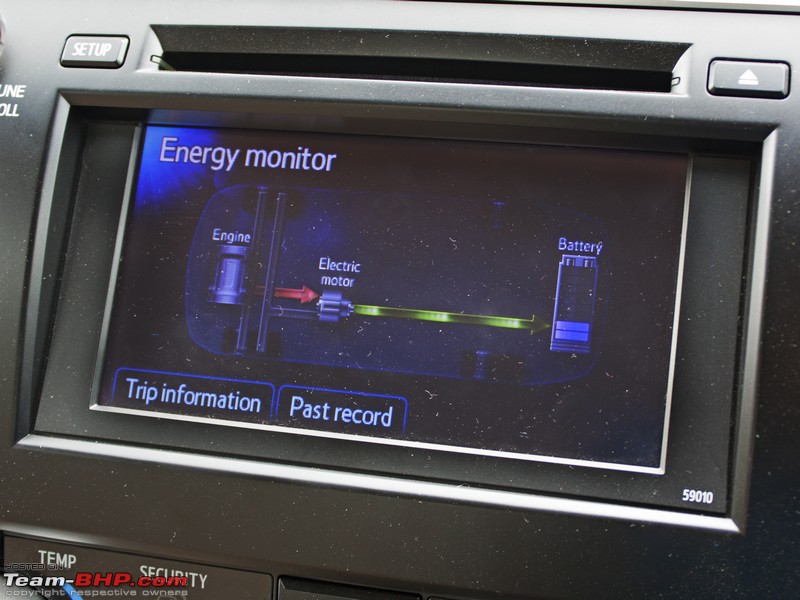 Medium-level acceleration results in the petrol engine driving the wheels as well as charging the battery: 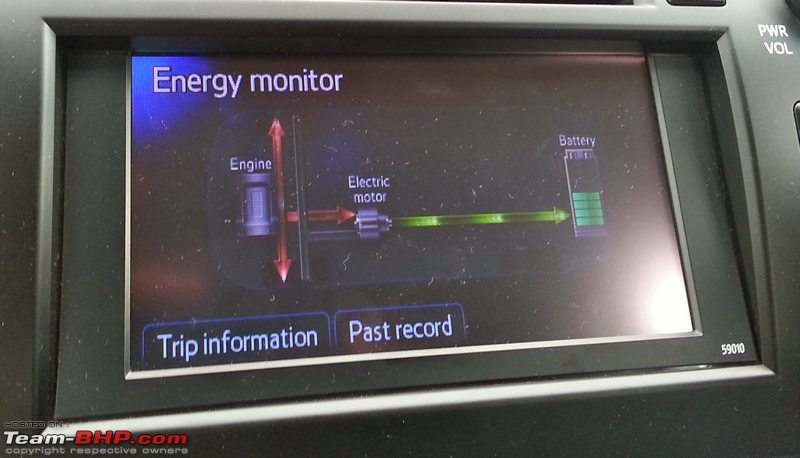 Full electric mode: 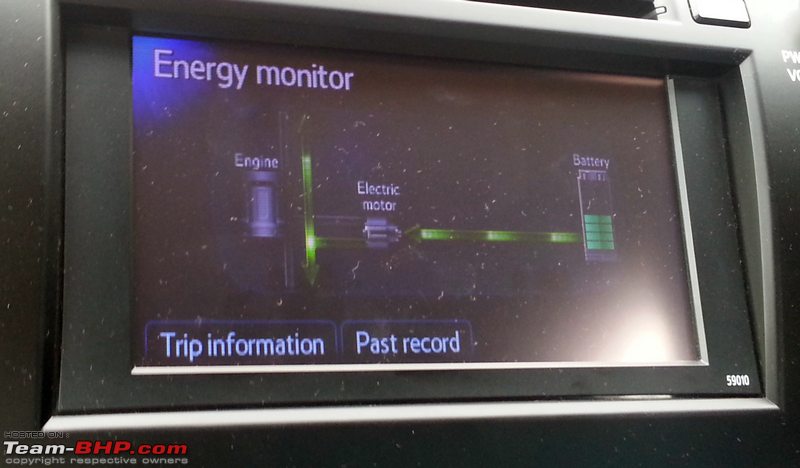 Trip computer shows you the fuel economy for the last drive, as well as the amount of energy generated by the regenerative brakes:  Notice the small energy monitor in the instrument console: 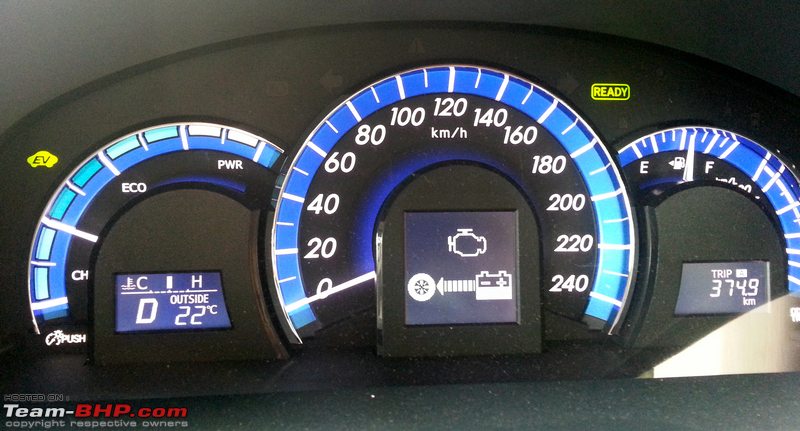 Last edited by Rehaan : 29th August 2013 at 14:04. |
| |  (21)
Thanks (21)
Thanks
 |
| The following 21 BHPians Thank Vid6639 for this useful post: | .anshuman, anandpadhye, Avikbrio, carrazy, dkaile, GTO, IronH4WK, KarthikK, neil.jericho, noopster, rave20, Rehaan, Researcher, RSR, S2!!!, SS-Traveller, Tejas@perioimpl, uday.ere, vb-saan, virtualdanger, vredesbyrd |
| | #7 |
| Team-BHP Support  | re: Review: 7th-gen Toyota Camry Hybrid (2013) Other Points: • Toyota conducted an 'Eco Run Challenge' during the event. The contest involved driving 3 laps around their test track - within 10 minutes - to get the best possible mileage. The track was set up with slalom cones, a U turn and a spin through the pits to simulate actual driving conditions. I managed to ace the contest with 22.8 kpl and 2 penalty points!! The highest of the day was 23.9 kpl, but with 19 penalty points as the driver overshot the 10 minute time limit. Trick was to maintain momentum and be feather light on the gas pedal. • Low CO2 emissions of 122.8 gm/km is comparable to 1.2L petrol hatchbacks! • 3 year / 100,000 kms standard warranty. No extended option. • Even though Toyota assembles the Camry in India, there is no localised content as of now. • A new Metallic Grey paint shade has been introduced. This is unique to the Hybrid. • When you engage reverse gear, the rear sun-blind rolls down automatically. The ORVMs tilt down as well. • The wooden inserts on the dash are dark brown on the Hybrid vs the reddish wood of the regular Camry. I prefer this darker shade. • Battery pack gets additional shielding for Indian conditions. In addition, Toyota says that the underbody protection has been beefed up. • Toyota is the class-topper when it comes to hybrids, with over 50 lakh sold worldwide. India is the 9th country to locally assemble / manufacture a Toyota hybrid. • Available in 4 colours: Metallic grey, white pearl, silver and black. • Disclaimer : Toyota invited Team-BHP for the Camry Hybrid Test-Drive. They covered all the expenses for this driving event. Last edited by GTO : 28th August 2013 at 16:11. |
| |  (19)
Thanks (19)
Thanks
 |
| The following 19 BHPians Thank Vid6639 for this useful post: | .anshuman, Avikbrio, carrazy, GrammarNazi, GTO, IronH4WK, KarthikK, khan_sultan, neil.jericho, noopster, rave20, Rehaan, Researcher, roby_dk, RSR, SS-Traveller, uday.ere, vb-saan, virtualdanger |
| | #8 |
| Team-BHP Support  | The Smaller yet Significant Things: These 2 pictures show a cooling vent on the left rear seat. Uses air from the back of the cabin to cool the battery pack in the boot:  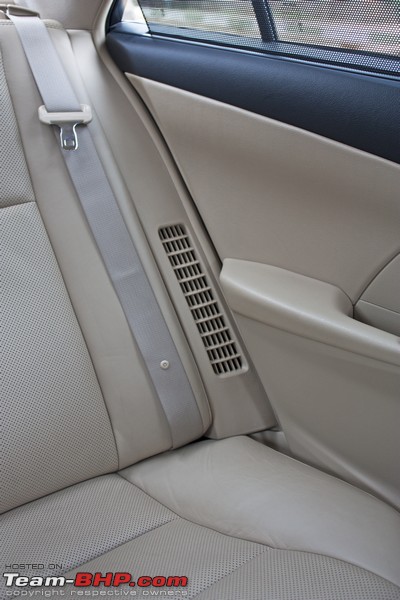 Smart key doesn't look as premium as that of the European competition:  Keyless entry. With the key in your pocket, simply place your finger over the 2 grooves to unlock the car: 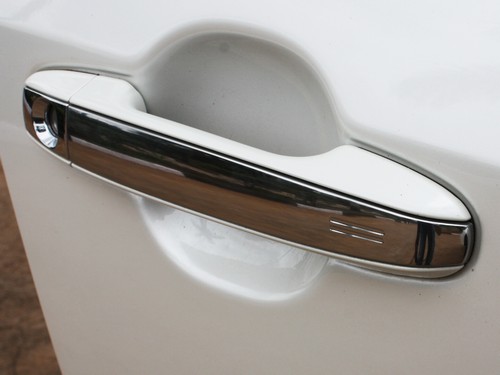 Rear camera is standard on the Hybrid. It has a really wide angle:  Clean underbody gets skid plates all through. Notice the multi-link suspension:  The ORVMs are auto-folding. You can set them to fold when you lock the car: 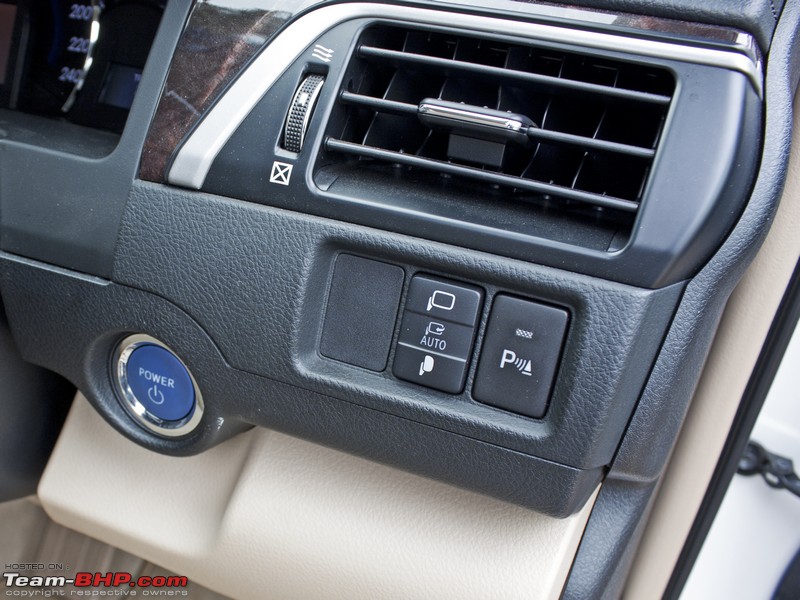 Battery for the electrical system is located in the boot. It's actually a smaller unit, as it isn't used to crank the engine:  Last edited by GTO : 28th August 2013 at 16:10. |
| |  (39)
Thanks (39)
Thanks
 |
| The following 39 BHPians Thank Vid6639 for this useful post: | .anshuman, .sushilkumar, 9thsphinx, Ahmed, Akshay1234, anilkumar, anToNIcHeN, Avikbrio, blackwasp, carrazy, condor, Coupé, dean5545, dkaile, ecosport rules, GTO, IronH4WK, K a s h, KarthikK, Kimified, MaheshY1, neil.jericho, noopster, prateekm, rave20, Rehaan, Researcher, rshanker, RSR, S2!!!, SDP, Shome, SS-Traveller, Stratos, Tejas@perioimpl, treadmark, uday.ere, vb-saan, virtualdanger |
| | #9 |
| Team-BHP Support  | re: Review: 7th-gen Toyota Camry Hybrid (2013) Thread moved from the Assembly Line to Official Reviews. Thanks for sharing! *Rates thread a well-deserved 5 stars* |
| |  (4)
Thanks (4)
Thanks
 |
| The following 4 BHPians Thank GTO for this useful post: | KarthikK, Researcher, roby_dk, Vid6639 |
| | #10 |
| BANNED Join Date: Nov 2011 Location: Bangalore
Posts: 1,380
Thanked: 3,385 Times
Infractions: 0/1 (7) | re: Review: 7th-gen Toyota Camry Hybrid (2013) Toyota pricing is off the charts for the segment, pricing closer to Superb Diesel should have helped. The difference with the petrol Superb top end is nearly 7 Lakhs, it will take a long time to recover any Hybrid associated benefits with this. Hybrid is here to stay, maybe 5 years from now, we will have this as a choice on regular cars. 38 Lakhs OTR in Bangalore in 320d pricing, most people will get the BMW /Audi instead of this. |
| |  ()
Thanks ()
Thanks
 |
| | #11 |
| Team-BHP Support  | re: Review: 7th-gen Toyota Camry Hybrid (2013) Excellent Review Vidyut. Writing this review must have been very different than writing about any other car. You had to research a lot about Hybrid technology before writing this one, or else it won't meet the TBHP standard for official car review.  When I drove the Hybrid Camry in Japan, I was hardly excited. I see your reaction is no different. It is a perfect chauffeur's car. I am glad to see they have changed the penalty points in the Eco Run Challenge. The ultra slow drivers were hardly penalized during my attempt. |
| |  (6)
Thanks (6)
Thanks
 |
| The following 6 BHPians Thank Samurai for this useful post: | blackwasp, KarthikK, Researcher, RSR, vb-saan, Vid6639 |
| |
| | #12 |
| Senior - BHPian Join Date: Nov 2009 Location: Germany
Posts: 2,856
Thanked: 1,544 Times
| re: Review: 7th-gen Toyota Camry Hybrid (2013) Interesting thread, do you by any chance have specifications of the electric motor, battery pack (V) ? Just skimmed through the review, sorry if I missed it somewhere. Which operating point strategy (1 point or follow up) do they use to optimize fuel consumption? How is the transition between ICE and E-Motor smoothed? Thanks ! Spike Last edited by SPIKE ARRESTOR : 28th August 2013 at 17:33. |
| |  ()
Thanks ()
Thanks
 |
| | #13 | |||
| Team-BHP Support  | re: Review: 7th-gen Toyota Camry Hybrid (2013) Quote:
I had to research a lot about the Hybrid Synergy Drive and was very attentive during the drive to see what is happening. This car is not like any other which you pen down how it drives based on what you feel. Quote:
Quote:
Last edited by Vid6639 : 28th August 2013 at 20:42. | |||
| |  (2)
Thanks (2)
Thanks
 |
| The following 2 BHPians Thank Vid6639 for this useful post: | Researcher, RSR |
| | #14 |
| BANNED Join Date: Dec 2005 Location: Ridin earth now
Posts: 1,280
Thanked: 348 Times
| re: Review: 7th-gen Toyota Camry Hybrid (2013) Mod Note : There are several spelling & grammatical errors in your posts. This negatively affects the forum experience for other readers. Kindly ensure that you proof-read your posts prior to submission. Also, it would be a good idea to use spell-checkers. Last edited by GTO : 29th August 2013 at 14:38. |
| |  ()
Thanks ()
Thanks
  |
| | #15 |
| BHPian | re: Review: 7th-gen Toyota Camry Hybrid (2013) Nice review Vidyut sir! The pricing is quite high, but as you said, the Germans cannot even attempt to match the rear seat comfort of the Camry. Hopefully, this will see more hybrids coming to India, after the flopped Civic Hybrid and the Prius. |
| |  (1)
Thanks (1)
Thanks
 |
| The following BHPian Thanks nipcarlover for this useful post: | RSR |
 |



